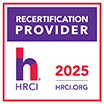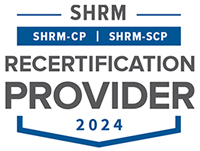+1-800-385-1627
support@trainhrlearning.com
0 items
Employee Handbooks: 2019 Updates
This webinar describes what employers expect of their employees and what employees can (should) expect from their employers.
90 Minutes
6 months
702643

Group Attendees: Any number of participants
Recorded Version: Unlimited viewing for 6 months ( Access information will be emailed 24 hours after the completion of live webinar)

The use of this seal confirms that this activity has met HR Certification Institutes (HRCI) criteria for recertification credit pre-approval.
This activity has been approved for
1.5 HR
(General) recertification credit
 TrainHRLearning is recognized by SHRM to offer Professional Development Credits (PDCs) for the SHRM-CP® or SHRM-SCP®.
?
TrainHRLearning is recognized by SHRM to offer Professional Development Credits (PDCs) for the SHRM-CP® or SHRM-SCP®.
?
1-hour and 15 minute concurrent conference session = 1.25 PDCs.
3-hour e-learning course = 3 PDCs.
The purposes and the scope of employee handbook policies and the practices are changing and expanding. From a siloed HR activity that creates insular documents concerned primarily with communicating the organizational work rules and benefits, employee handbook policies and practices have evolved into a critical component of an organization-wide management process that maximizes organizations' achievement of business objectives, enhances the value of their human capital, and minimizes legal risk.
To increase the effectiveness of their employment policies, organizations will have to:- Enhance their business, operational, and legal intelligence to ensure they have identified the changing external and internal factors that affect their policies
- Increase internal stakeholder participation in the handbook development process to obtain greater employee commitment and operational alignment
- Establish new metrics to assess handbook policy and practices performance and measure the achievement of organization goals
- Implement internal controls that identify and alert management when employee handbook process failures occur
- Enhance the employment brand
- Play a key role in recruitment and retention
- Enhance employee relations, employee morale, and productivity
- Contribute to uniform and consistent application, interpretation, and enforcement of organizational policies and rules
- Protect the organization against claims of improper employee/supervisor conduct
- Reduce the organization's exposure to employment related liabilities
Why should you Attend: Employee handbooks are a critical tool in providing important information to employees. They describe what employers expect of their employees and what employees can (should) expect from their employers. They provide critical information about employers and their workplaces and how employees are expected to fit in.
Employee handbooks further formalize the mutual expectations of organizations and their employees. In delineating these expectations employee handbooks create opportunities and risks for employers. Handbooks provide organizations with the opportunity to enhance the value of their human capital, make their organizations more competitive, and improve individual and organizational performance. Conversely, handbooks can impede the achievement of business objectives, increase employment related liabilities, and reduce managerial prerogatives by making promises or committing to certain procedural safeguards that the organization did not intend to make. As noted in the recent memorandum from the General Counsel of the NLRB: incorrectly designed employee handbooks can violate the law and having a "chilling effect" on employees' activities.
Thus employee handbooks increasingly provide for employers the opportunity to make their work force more committed and supported of their goals. Unfortunately they also provide the basis for employees' legal action and can significantly reduce employees' commitment to organizational success.
Areas Covered in the Session:
- Key employee handbook issues in 2019
- A review of the NLRB's recent memorandum on employee handbooks
- How organizations can reduce the gap between policy issuance and effective implementation
- Review the basics of employee handbook development
- Discuss the expanding purposes and scope of employee handbooks
- Learn the dimensions of critical handbook policies
- Understand the framework of employee handbook audits activities
Who Will Benefit:
- HR Professionals
- Risk Managers
- Internal Auditors
- In-house Counsel
- CFOs
- CEOs
- Management Consultants
- Other Individuals who Want to Learn how to Use Develop and Implement Employee Handbooks
 Ronald Adler is the president-CEO of Laurdan Associates, Inc., a veteran owned, human resource management consulting firm specializing in HR audits, employment practices liability risk management, HR metrics and benchmarking, strategic HR-business issues and unemployment insurance.He has more than 37 years of HR consulting experience working with U.S. and international firms, small businesses and non-profits, insurance companies and brokers, and employer organizations.
Ronald Adler is the president-CEO of Laurdan Associates, Inc., a veteran owned, human resource management consulting firm specializing in HR audits, employment practices liability risk management, HR metrics and benchmarking, strategic HR-business issues and unemployment insurance.He has more than 37 years of HR consulting experience working with U.S. and international firms, small businesses and non-profits, insurance companies and brokers, and employer organizations.
Mr. Adler is a co-developer of the Employment-Labor Law Audit (the nation’s leading HR auditing and employment practices liability risk assessment tool.
Mr. Adler is an adjunct professor at Villanova University’s Graduate Program in Human Resources Development and teaches a course on HR auditing. Mr. Adler is a certified instructor on employment practices for the CPCU Society and has conducted continuing education courses for the AICPA, the Institute of Internal Auditors, the Institute of Management Consultants, and the Society for Human Resource Management.
